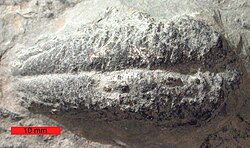Ichnology


Ichnology is the study of trace fossils of once-living things.[1]
Burrows, trackways, trails and borings are all examples of traces made by organisms.[1] Scientists study traces made by plants and animals to try to determine their behavior.[2] An ichnologist is a scientist whose area of study and research is ichnology.
A species name given to a fossil is called an ichnospecies. It is written in italics with a lower case initial. It is shown to be an ichnospecies by the abbreviation "isp".[3]
Examples
- Later Cambrian trace fossils from intertidal settings include Protichnites and Climactichnites, and others.
- Mesozoic dinosaur footprints including Ichnotaxon such as Grallator and Atreipus (bipedal theropods) and Anomoepus.
- Triassic to Recent termite mounds, which can be several square kilometers of sediment
- Possible Avian footprints such as Saurexallopus.
Ichnology Media
Chirotherium footprints in a Triassic sandstone
The trackway Protichnites from the Cambrian, Blackberry Hill, central Wisconsin
Cross-section of mammoth footprints at The Mammoth Site, Hot Springs, South Dakota
This coprolite shows distinct top and bottom jaw bite marks, possibly from a prehistoric gar fish. Discovery location: South Carolina, US; age: Miocene; dimensions: 144.6 mm × 63.41 mm (5.693 in × 2.496 in); weight: 558 g (1 lb 3.7 oz)
Eubrontes, a dinosaur footprint in the Lower Jurassic Moenave Formation at the St. George Dinosaur Discovery Site at Johnson Farm, southwestern Utah
Climactichnites wilsoni, probably trails from a slug-like animal, from the Cambrian, Blackberry Hill, central Wisconsin. The ruler in the background is 45 cm (18 in) long.
Petroxestes borings in a hardground from the Upper Ordovician of southern Ohio
Rusophycus trace fossil from the Ordovician of southern Ohio. Scale bar is 10 mm.
References
- ↑ 1.0 1.1 "ichnology". Dictionary.com. Retrieved February 6, 2017.
- ↑ "What is Ichnology?". Emery College of Arts and Sciences. Archived from the original on March 18, 2017. Retrieved February 6, 2017.
- ↑ ichnospecies. Oxford Reference. Oxford University Press. 20 March 2008. ISBN 978-0-19-921194-4. Retrieved February 6, 2017.








